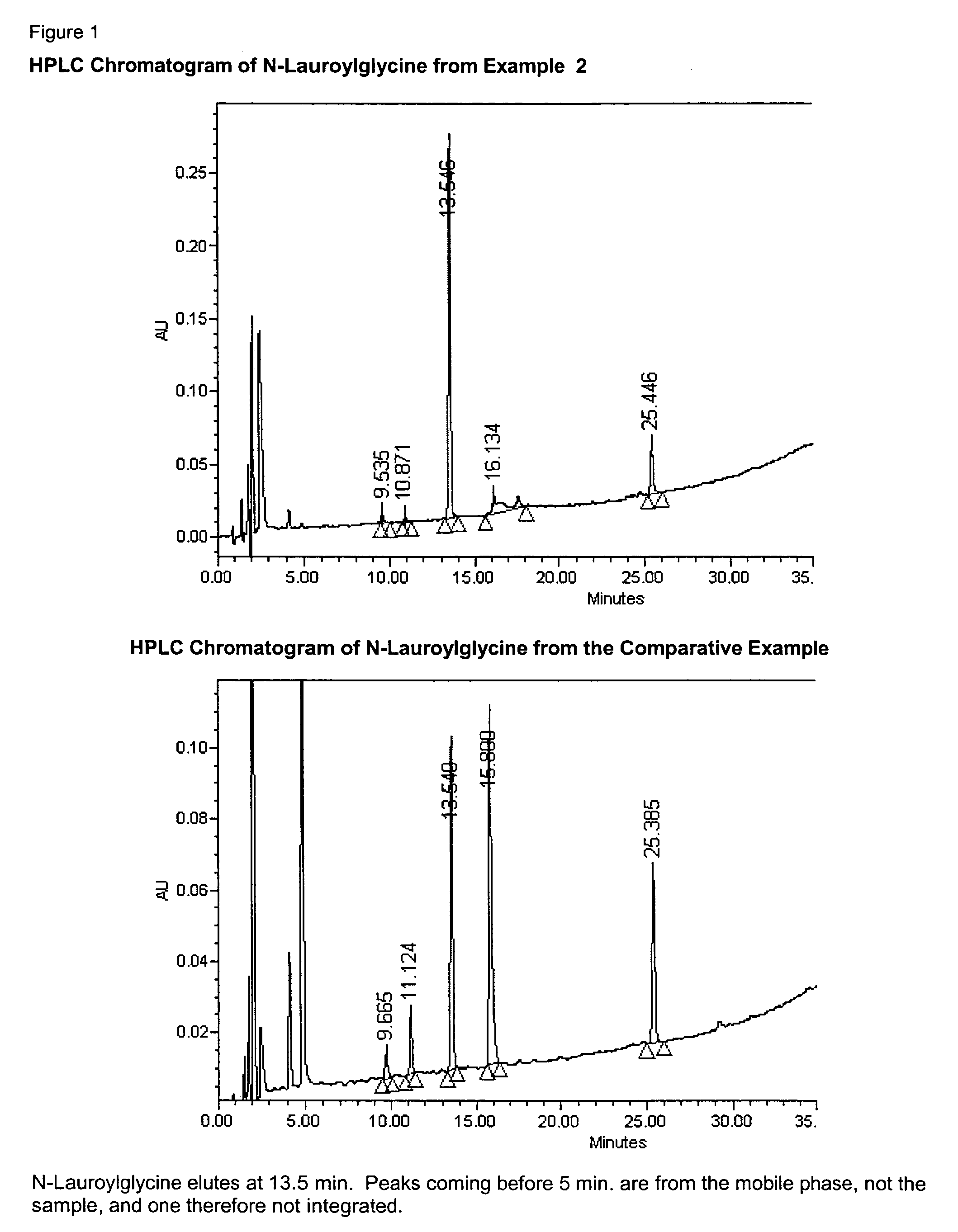Process for converting primary amidoalcohols to amidocarboxylic acids in high yield
- Summary
- Abstract
- Description
- Claims
- Application Information
AI Technical Summary
Benefits of technology
Problems solved by technology
Method used
Image
Examples
example 1
Oxidation of N-lauroylethanolamide (LMEA) in THF with 6.5 eq. of NaOCl, and Acid Work-Up
[0067]33 mg (4.5 mol %) of KBr (co-catalyst) was dissolved in 6 mL of water. Tetrahydrofuran solvent THF (31 mL), AA-TEMPO catalyst (25 mg, 2.5 mol %) and 1.5 g N-lauroylethanolamide (LMEA) were added with stirring to give a homogeneous water-white solution. Sodium hypochloride oxidizing agent (22 mL of 11.5% aq. Solution, 6.5 equivalents) and 2.3 mL of 2 NaOH (to maintain pH above 7) were mixed. The combined solution was added dropwise to the solution of LMEA and catalyst over a period of 1.5 hour. A separate aqueous layer immediately formed upon addition of the sodium hypochlorite solution. The pH of the aqueous layer was 12.7 after addition of the first 3.5 ml. The temperature was maintained below 32° C. with an ice-water bath. The reaction was stirred for 0.5 hr. more until complete conversion of LMEA to LG as determined by reversed-phase High Pressure Liquid Chromatography, abbreviated HPLC....
example 2
Oxidation of LMEA with 3.25 eq. of NaOCl, and Acid Work-Up
[0069]The procedure in Example 1 was followed, except that the amount of sodium hypochlorite was decreased to 3.25 equivalents. The isolated yield was 103% (includes residual water), showing that the oxidation works with the lower sodium hypochlorite amount.
example 3
Oxidation of LMEA with 3.25 eq. of NaOCl, Isolation of Sodium Salt
[0070]In this example, sodium N-lauroylglycinate is obtained by a small modification of the isolation procedure. The procedure in Example 2 was followed. The pH was 7.8 upon completion of the reaction. In this case the THF layer was separated without acidification. The aq. layer was extracted twice with 30 mL of THF. After extraction, the pH of the aq. layer was 8.3. The combined THF layers were concentrated on a rotary evaporator and dried in vacuo to give sodium N-lauroylglycinate in 99% yield. Unlike N-lauroylglycine, the sodium N-lauroylglycinate dissolves in water and affords a foam upon agitation.
PUM
| Property | Measurement | Unit |
|---|---|---|
| Fraction | aaaaa | aaaaa |
| Molar density | aaaaa | aaaaa |
| Temperature | aaaaa | aaaaa |
Abstract
Description
Claims
Application Information
 Login to View More
Login to View More - R&D
- Intellectual Property
- Life Sciences
- Materials
- Tech Scout
- Unparalleled Data Quality
- Higher Quality Content
- 60% Fewer Hallucinations
Browse by: Latest US Patents, China's latest patents, Technical Efficacy Thesaurus, Application Domain, Technology Topic, Popular Technical Reports.
© 2025 PatSnap. All rights reserved.Legal|Privacy policy|Modern Slavery Act Transparency Statement|Sitemap|About US| Contact US: help@patsnap.com


